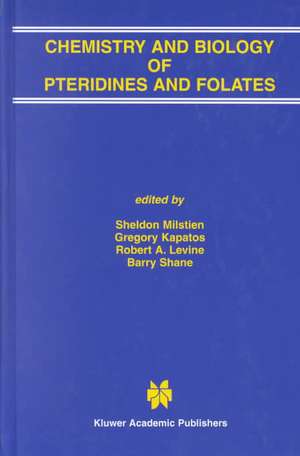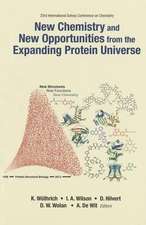Chemistry and Biology of Pteridines and Folates: Proceedings of the 12th International Symposium on Pteridines and Folates, National Institutes of Health, Bethesda, Maryland, June 17–22, 2001
Editat de Sheldon Milstien, Gregory Kapatos, Robert A. Levine, Barry Shaneen Limba Engleză Hardback – 30 mai 2002
Since pteridine and folate biology uses concepts and experimental techniques drawn from all of these disciplines, the breadth of this volume is its great strength, bringing together researchers from a wide variety of fields including biochemistry, chemistry, physics, biophysics, genetics, microbiology, cell and molecular biology, virology, immunology, cancer, neurobiology and medicine. This volume should be a valuable and unique reference work for scientists with interests in these areas as well as those seeking up to date information.
| Toate formatele și edițiile | Preț | Express |
|---|---|---|
| Paperback (1) | 963.77 lei 6-8 săpt. | |
| Springer Us – 4 noi 2012 | 963.77 lei 6-8 săpt. | |
| Hardback (1) | 970.07 lei 6-8 săpt. | |
| Springer Us – 30 mai 2002 | 970.07 lei 6-8 săpt. |
Preț: 970.07 lei
Preț vechi: 1183.01 lei
-18% Nou
Puncte Express: 1455
Preț estimativ în valută:
185.62€ • 194.50$ • 153.45£
185.62€ • 194.50$ • 153.45£
Carte tipărită la comandă
Livrare economică 12-26 aprilie
Preluare comenzi: 021 569.72.76
Specificații
ISBN-13: 9780792376750
ISBN-10: 0792376757
Pagini: 677
Ilustrații: XXIII, 677 p.
Dimensiuni: 155 x 235 x 38 mm
Greutate: 1.15 kg
Ediția:2002
Editura: Springer Us
Colecția Springer
Locul publicării:New York, NY, United States
ISBN-10: 0792376757
Pagini: 677
Ilustrații: XXIII, 677 p.
Dimensiuni: 155 x 235 x 38 mm
Greutate: 1.15 kg
Ediția:2002
Editura: Springer Us
Colecția Springer
Locul publicării:New York, NY, United States
Public țintă
ResearchDescriere
Pteridine and folate research has long been recognized as important for many biological processes, such as amino acid metabolism, nucleic acid synthesis, neurotransmitter synthesis, cancer, cardiovascular function, and growth and development of essentially all living organisms. Defects in synthesis, metabolism and/or nutritional availability of these compounds have been implicated as major causes of common disease processes, e.g. cancer, inflammatory disorders, cardiovascular disorders, neurological diseases, autoimmune processes, and birth defects.
Since pteridine and folate biology uses concepts and experimental techniques drawn from all of these disciplines, the breadth of this volume is its great strength, bringing together researchers from a wide variety of fields including biochemistry, chemistry, physics, biophysics, genetics, microbiology, cell and molecular biology, virology, immunology, cancer, neurobiology and medicine. This volume should be a valuable and unique reference work for scientists with interests in these areas as well as those seeking up to date information.
Since pteridine and folate biology uses concepts and experimental techniques drawn from all of these disciplines, the breadth of this volume is its great strength, bringing together researchers from a wide variety of fields including biochemistry, chemistry, physics, biophysics, genetics, microbiology, cell and molecular biology, virology, immunology, cancer, neurobiology and medicine. This volume should be a valuable and unique reference work for scientists with interests in these areas as well as those seeking up to date information.
Cuprins
Making Methionine: A Love Affair with Folate.- Structure Elucidations of Dimeric Pteridines.- A Selective Procedure for 6-Subsituted Pterin Derivatives: Synthesis and Substitution of Pterin 6-Triflate.- Solution and Solid Phase Synthesis of Pteridines, Purines and Related Compounds.- Synthesis of Pteridines with C-2 and C-6 Functional Group Diversity.- Stereospecific Synthesis of 2-Desamino-Tetrahydropterins as Probes of Hydroxylase Cofactor Recognition.- New Pyranopterin Chemistry Related to Molybdenum and Tungsten Enzymes.- Application of FDCD Spectroscopy for Determination of Chiralities of Biologically Important Pteridines.- Photo-Oxidation of Sepiapterin Produces Pterin-6-Carboxylic Acid and H2O2In Vitro.- Regulation of Tyrosine Hydroxylase by S-Glutathiolation: Relevance to Conditions Associated with Dopamine Neuronal Damage.- The Conformation of Tetrahydro-Biopterin Free and Bound to Aromatic Amino Acid Hydroxylases and NOS.- Regulatory Properties of the Tetrahydropterin Cofactor in the Reaction Catalyzed by Human Tyrosine Hydroxylase Isoforms 1–4.- Structure and Regulation of Phenylalanine Hydroxylase, and Implications for Related Enzymes.- Interaction of Phosphorylated Tyrosine Hydroxylase with 14-3-3 Proteins: Effects on Phosphorylation Kinetics.- Mechanistic Studies of Tryptophan Hydroxylase.- Role of Phe313/Trp326 in Determining Substrate Specificity in Tryptophan and Phenylalanine Hydroxylases.- Possible Contributions of Labile Asparagine Residues to Differences in Regulatory Properties of Human and Rat Phenylalanine Hydroxylase.- 3-(2-Thienyl)-L-Alanine as a Competitive Substrate Analogue and Activator of Human Phenylalanine Hydroxylase.- The N-Terminus of Human Tyrosine Hydroxylase is Responsible for its Association with Phospholipid Bilayers.- Mechanisms of Tyrosine Hydroxylase Activation by Stress Activated Protein Kinases.- Substrate Specificities of Phenylalanine and Tyrosine Hydroxylase: Role of Aspartate 425 of Tyrosine Hydroxylase.- Mutation of W457 Alters N-Hydroxy-L-Arginine Oxidation by Inducible NO Synthase: A Single Turnover Study.- Regulation of Rat Hepatic Phenylalanine Hydroxylating System In Vivo.- Estradiol Modulates GTP Cyclohydrolase I Gene Expression in Brain Catecholaminergic Systems.- PKC-Mediated Regulation of GTP Cyclohydrolase I in Mast Cells and Renal Mesangial Cells.- Regulation of GTP Cyclohydrolase I by Estrogen.- Sexually Dimorphic GTP Cyclohydrolase I Gene Expression is Independent of Sex Hormones.- Studies on the Reaction Mechanism of GTP Cyclohydrolase I.- Site-Directed Mutagenesis of Residues in the Active Site of Sepiapterin Reductase.- Determination of Residues Of Sepiapterin Reductase Phosphorylated by Ca2+/Calmodulin-Dependent Protein Kinase II.- The Interaction of GTP Cyclohydrolase I and GTP Cyclohydrolase Feedback Regulatory Protein Can be Detected Using the Yeast Two-Hybrid System.- Co-Induction of Tetrahydrobiopterin and Catecholamine Syntheses in V-1-Overexpressing PC12D Cells.- Sepiapterin Administration Raises Tissue BH4 Levels More Efficiently than BH4 Supplement in Normal Mice.- Cells Take up BH4, Oxidize it, and the Oxidized Biopterin is Preferentially Released.- Catecholamines-Up, a Negative Regulator of Tyrosine Hydroxylase and GTP Cyclohydrolase I in Drosophila Melanogaster.- The Pteridine Pathway in the Zebrafish, Danio Rerio: Development in Neural Crest-Derived Cells and its Control by GTP Cyclohydrolase I.- Pteridine and Nitric Oxide Biosynthesis in Physarum Polycephalum.- Pteridines and Pigment Granules of Wing Scales Concerned with Sexual Difference in Wing’s Capability Reflecting Near-UV Rays in the Japanese Cabbage Butterfly, Pieris Rapae Crucibora.- Tetrahydrobiopterin, Nitric Oxide Synthesis and cGMP Concentrations in Mutants of Physarum Polycephalum with Altered Sporulation Behavior.- BH4 and NOS are Involved in Light Controlled Development of Sporangiophores in the Fungus Phycomyces Blakesleeanus.- Determination of Tetrahydropterins as Native Pteridines in Two Microorganisms, Tetrahymena Pyriformis and E. coli.- Identification of the Sulfurtransfer Pathway for the Generation of the Dithiolene Moiety of Molybdopterin in Escherichia Coli.- Tetrahydrobiopterin and Vascular Endothelial Function.- L-Ascorbic Acid Increases Intracellular Tetrahydrobiopterin Via a Chemical Stabilization and Potentiates Nitric Oxide Synthesis in Endothelial Cells.- The Redox Status of Bound Pterin Cofactor Determines Whether eNOS Produces NO or Superoxide Anion: [3H]-BH4 Binding Studies Provide Insights into Vascular Pathophysiology.- Sepiapterin Reductase Deficiency: Molecular Analysis in a New Case Presenting with Neurotransmitter Deficiency Without Hyperphenylalaninemia.- Molecular Basis of DOPA-Responsive Dystonia.- Human Nigrostriatal Dopamine Neurons Express Low Levels of GTP Cyclohydrolase I mRNA.- Immunosuppressive Effects of the 4-Amino Analogue of Tetrahydrobiopterin.- Tetrahydrobiopterin Responsive Hyperphenylalaninemia Without Biopterin Deficiency.- The Fate of Intravenously Administered Tetrahydrobiopterin and its Implications for Heterologous Gene Therapy of Phenylketonuria.- Influence of Hydrogen Peroxide (H2O2) on Pterin Homeostasis in the Depigmentation Disorder Vitiligo.- Catechol-O-Methyltransferase Inhibition in the Treatment of Tetrahydrobiopterin Deficiency.- Changes in Dihydropteridine Reductase (DHPR) Activity of the Occupationally Lead Exposed Workers.- Clinical Utility of Pteridine Measurement in Cerebrospinal Fluid.- Effect of Ascorbic Acid in Measurement of Serum Pteridine Concentration.- The Effect of Tetrahydrobiopterin (BH4) on Sperm Motility.- Tetrahydrobiopterin Deficiency in Diabetic Rats.- The Effect of Tetrahydrobiopterin (BH4) on Diabetic Nephropathy in Streptozotocin (Stz) Induced Diabetic Rats.- Determination of Sepiapterin and Sepiapterin Reductase in Human Skin.- Neopterin, an Immunodiagnostic and Oxidative Stress Indicator.- Role of Neopterin in Immune Monitoring in Transplant Medicine.- Neopterin and 7,8-Dihydroneopterin-Induced Signal Transduction Cascades in Cell Lines.- Determination of Neopterin Levels in Gingival Crevicular Fluid (GCF).- Neopterin and Biopterin Levels in Pregnancy.- Tetrahyrdobiopterin (BH4)-Mediated Neuronal Death Following Intrastriatal Kainic Acid: Implications for Parkinson’s Disease.- Inhibition of Oxidative Stress During Developmental Cell Death: Cellular and Behavioral Effects.- The Role of Tetrahydrobiopterin (BH4) in Trophic Factor Withdrawal-Induced Apoptosis in PC12 Cells.- Apoptotic Death of PC12 Cells Induced by Ischemia-Like Conditions is Mediated by Tetrahydrobiopterin (BH4) Metabolism.- New Approaches Towards Inhibitors of Folate-Dependent Enzymes: Rapid Synthesis of 5-Deazapterins from Uracil Derivatives.- Solid and Solution Phase Strategies for the Synthesis of Potential Inhibitors of Folate Biosynthesis.- Progress Towards the Synthesis of Pyrimidodiazepine-Based Folates as Potential Inhibitors of Glycinamide Ribonucleotide Formyltransferase.- Role of P53 Status on Sensitivity to Thymidylate Synthase Inhibitors and Induction of Apoptosis.- Synthesis of N-[4-[(2-Amino-6-Methyl-3,4-Dihydro-4-Oxo-7h-Pyrrolo[2,3-D]-Pyrimidin-5-YI)Methyl]Benzoyl]-L-Glutamic Acid as an Antifolate.- Effect of Bridge Truncation of Classical 2,4-Diamino-5-Substituted Furo [2,3-D]Pyrimidine and 2-Amino-4-Oxo-6-Substituted Pyrrolo[2,3-D]Pyrimidine on Antifolate Activity.- Selection of Methotrexate-Resistant Lactobacillus Casei in the Presence of Folate or 5-Formyl-Tetrahydrofolate Affects the Resistance Mechanism.- Molecular Mechanisms of Resistance to Antimalarial Antifolate Drug Pyrimethamine-Sulfadoxine.- 5-Fluorouracil Induction of Fas and Apoptosis in Colon Cancer Patients: Relation of Clinical Outcome with Thymidylate Synthase, McI-1 and Rb.- Synthesis of 2- or 4-Seleno Analogues of dUMP and FdUMP, and the Corresponding Nucleosides. Interactions with Mammalian Tumor Thymidylate Synthase of the Selenonucleotides and Inhibition of Tumor Cell Growth by the Selenonucleosides.- Induction of Resistance to the Multi-Targeted antifolate MTA (Ly231514) in Widr Human Colon Cancer Cells.- Mutational Studies of an Essential Glutamate Residue in Escherichia coli Folylpolyglutamate Synthetase with a Role in ATP Binding.- Rapid Purification of the T-Protein of the Glycine Cleavage System from Rabbit Liver.- Effects of Cellular Glycine on Cell Proliferation.- Microarray Analysis of Genes Induced by Methionine Starvation and Growth on Different Sulfur Sources in Yeast.- Gene Structure and Expression of Trichinella spiralis Thymidylate Synthase.- Lack of Mutation of L1210 Thymidylate Synthase with Altered Sensitivity to FdUMP Inhibition.- Enzymes of Thymidylate Biosynthesis in Trichinella pseudospiralis Muscle Larvae and Caenorhabditis elegans Dauer Larvae.- Thymidylate Synthase Heterogeneity Assessed by Monoclonal Antibodies.- Structure-Based Modeling of Reversed N9-C10 Bridge Antifols with Human, Pc and Tg DHFR.- Regulation of Mammalian Methionine Synthase by B12.- Biochemical Studies of Human Methionine Synthase Reductase.- Model Studies for the B12 Dependent Methyltransferases.- Betaine-Homocysteine S-Methyl-Transferase (BHMT) Transcription is Inhibited by S-Adenosylmethionine (AdoMet).- Can Elevated Plasma Homocysteine Levels Result in the Inhibition of Intracellular Methyltransferases?.- The Neuropathy of Disturbed Brain Methylation Reactions.- Dopamine-Stimulated Solid-State Signaling: A Novel Role for Single-Carbon Folates in Human Attention.- Is Moderate Hyperhomocysteinemia Due to Folic Acid Depletion Rather than Insufficient Dietary Intake?.- C677t MTHFR Genotype is a Risk Factor for Thromboembolism: Comparison of T Allele Frequency and Homocysteine Level Between Female Thromboembolic and Non-Thromboembolic Vascular Patients, NTD Mothers and Matched NTD Controls.- Molecular Bases of Hyper-Homocysteinemia Due to Inborn Errors of Folate and Cobalamin Metabolism.- Vitamin B6 (PLP) and Neural Tube Defects: Is There an Association?.- Erythrocyte Folate Levels in Operating Room Personnel.- A Human Ileostomy Model to Determine Folate Bioavailability From Food.- 12 Channel Coulometric Electrochemical Detection for the Identification of Polyglutamate Homology Amongst Cellular Folates.- Gastro-Intestinal pH Modulates Facile Interconvertion of Native Formylfolates During Absorption.- Control Of Folate Production in Lactic Acid Bacteria by Using Metabolic Engineering.- Evidence for a Cryptic Gene that Enables E. coli to Specifically Transport Folate Analogs.- Folate Transport Abnormalities and Congenital Defects.- Role of Multidrug Resistance Proteins (MRP) in Resistance to Antifolates and Folate Homeostasis.- Kinetics Of Reduced Folate Carrier- and Membrane-Associated Folate Receptor-Mediated Transport of Antifolates.- Cell Biology and Regulation of the Intestinal Folate Absorption Process.- Participants.
















